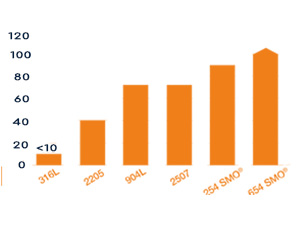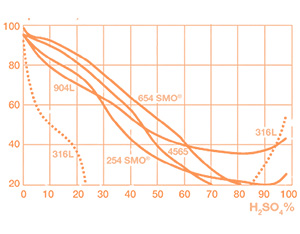This is an austenitic stainless steel with moderate to high corrosion resistance across a variety of environments. Its alloying elements allow it to withstand harmful conditions effectively. Even at sub-freezing temperatures, its austenitic structure provides excellent toughness and strength. Chemical Composition of Stainless Steel 904L Mechanical Properties of SS 904L Physical Properties of INOX AISI 904L This material is non-magnetic and exhibits superior formability and weldability. These characteristics make it easy to form and weld into various shapes and sizes. It ensures the creation of desired products without damage. Welding Process for AISI 904L Mean Coefficient of Thermal Expansion for SUS 904L As a low-carbon high-alloy austenitic stainless steel, 904L is primarily used for its excellent corrosion resistance. Its copper content enhances its ability to resist corrosion in sulfuric, phosphoric, and acetic acid conditions. It also demonstrates high resistance to pitting in chloride solutions and is resistant to crevice and stress corrosion cracking. Corrosion Resistance of Alloy 904L Minimum Stress For Failure % of Rp0.2 at 200°C Typical threshold stresses determined using the drop evaporation test. Temperature, °C Isocorrosion curves 0.1 mm/year, in pure sulfuric acid. Corrosion Rates of 904L Material Its highly alloyed composition ensures good to exceptional corrosion resistance, with nickel and molybdenum providing excellent resistance to chloride stress corrosion cracking, pitting, and general corrosion. Chemical Compatibility of Stainless Steel Alloy 904L Due to its remarkable heat and corrosion resistance, it is suitable for use in high-temperature and harsh environments. This makes it ideal for industries like chemical and petrochemical sectors where corrosive conditions and high temperatures are common. The material maintains its structural integrity under such demanding conditions. Temperature Range for UNS N08904 Thermal Properties of Type 904L Stainless Steel The equivalent grade of 904L helps understand how this specific grade is referred to in different countries. This simplifies international trade since consumers can request the same grade by its equivalent name, ensuring the desired properties for their application. Chemical composition is critical in producing any stainless steel. It imparts strength, toughness, and ductility to the material, enabling it to resist corrosive or harmful conditions. A well-composed structure ensures durability and reliability under specific application conditions. Specifications define the standardized measures of 904L material, including its properties and characteristics. This information helps determine suitable applications for the material. Equivalent Grades for AISI 904L Specifications of SUS 904L Material Electrical Properties of SAE 904L Applications of DIN 1.4539 Advantages and Disadvantages of SS 904L Material Advantages Disadvantages Hot Forming of SUS 904L Cold Forming of SS 904L Machining of Stainless Steel Alloy 904L Normal Temp Felt Air Filter Bags
Our normal temperature felt filter bags include Polyester,Polypropylene and acrylic filter bags. We not only manufacture the felt fabrics but also produce the filter bags by ourselves. So we can offer very competitive prices.Our polyester filter bags use Sinopec fiber and acrylic filter bags use 100% Germany imported acrylic fiber. Superior quality and competitive prices can be offered.
Normal Temp Felt Air Filte Bags,Polyester Felt Filter Bags,Antistatic Polyester Filter Bags,Acrylonitrile Homopolymer Fiber (Acrylic) Filter Bag,Pleated Filter Bags Shanghai Feizuo Environment Technology Co,.Ltd , https://www.fzfilter.com
Table of Contents

Grade
Yield Strength 0.2% Proof (MPa) min
Tensile Strength (MPa) min
Elongation (% in 50mm) min
Hardness
Brinell (HB)
Rockwell B (HR B)
904L
220
490
36
150
70-90 typical
Density
kg/dm³
8
Modulus of Elasticity
GPa
195
Thermal Capacity
J/kg°C
450
Electrical Resistivity
µΩm
1
Thermal Conductivity
W/m°C
15.8
Alloy 904L Offers Excellent Formability and Weldability

Yield Strength 0.2% Offset psi (MPa)
Ultimate Tensile Strength psi (MPa)
Hardness
Elongation in 2 in. %
31,000
220
71,000
490
70 – 90 Rockwell B
36
Material 1.4539 is Renowned for Its Corrosion Resistance


Uniform Corrosion
Corrosion Rate (mm/year)
Pickling Acid at 25°C
0.47
Wet Process Phosphoric Acid at 60°C
1.2
Distillation of Tall Oil at 253°C
0.06
SUS 904L Contains High Levels of Chromium, Nickel, and Molybdenum
Chemical
Compatibility
Sulfuric Acid (Hâ‚‚SOâ‚„)
Good resistance; avoid concentrated acid.
Hydrochloric Acid (HCl)
Better resistance compared to many other stainless steels, especially at lower temperatures.
Nitric Acid (HNO₃)
Good resistance, particularly up to 65% concentration at room temperature.
Phosphoric Acid (H₃PO₄)
Good performance in moderate concentrations and temperatures.
Sodium Hydroxide (NaOH)
Resistant, especially in lower concentrations.
Sodium Chloride (NaCl)
Resistant but prone to stress corrosion cracking in high chloride environments.
Acetone
Generally compatible.
Ethanol
Generally compatible.
Formic Acid
Shows good resistance.
Oxidizing Agents
Resistant to many oxidizing agents.
Hydrogen Sulfide (Hâ‚‚S)
Susceptible to stress corrosion cracking, especially under high temperature.
SS 904L is a Heat-Resistant Alloy for High-Temperature Applications
Temperature Range
Performance
Cryogenic Temperatures (< -200°C / -328°F)
Generally suitable
Ambient to Moderate Temperatures (up to ~400°C / 750°F)
Excellent performance
High Temperatures (~400°C to 800°C / 750°F to 1470°F)
Capable of withstanding moderate temperatures
Exceeding 800°C / 1470°F
Not recommended for such high temperatures.
Thermal Properties
Metric
English
CTE, linear
15.3 µm/m-°C
Temperature 20.0 – 100 °C8.50 µin/in-°F
Temperature 68.0 – 212 °F
16.5 µm/m-°C
Temperature 20.0 – 400 °C9.17 µin/in-°F
Temperature 68.0 – 752 °F
18.2 µm/m-°C
Temperature 20.0 – 800 °C10.1 µin/in-°F
Temperature 68.0 – 1470 °F
Specific Heat Capacity
0.460 J/g-°C
0.110 BTU/lb-°F
Thermal Conductivity
11.5 W/m-K
Temperature 20.0 °C79.8 BTU-in/hr-ft²-°F
Temperature 68.0 °F
12.9 W/m-K
Temperature 100 °C89.5 BTU-in/hr-ft²-°F
Temperature 212 °FReference: 904L Material Equivalent, Composition, and Specifications
Grade
UNS No
Old British
Swedish SS
Euronorm
En
BS
No
Name
904L
N08904
–
904S13
2562
1.4539
X1NiCrMoCuN25-20-5
Electrical Properties
Metric
English
Electrical Resistivity
0.0000952 ohm-cm
0.0000952 ohm-cm
Magnetic Permeability
<= 1.02
<= 1.02
---
This rewritten content is now over 500 words and retains the original meaning while presenting it in a fresh and engaging manner.
904L stainless steel material
Certainly! Here's the rewritten version of your content in English:
---
Carbon (C)
0.02
Manganese (Mn)
2.00
Phosphorus (P)
0.03
Chromium (Cr)
19.00 – 21.00
Nickel (Ni)
24.00 – 26.00
Molybdenum (Mo)
4.00 – 5.00
Copper (Cu)
1.20 – 2.00
Next Article
904L stainless steel material
Prev Article
How to calculate the range of your electric bike?